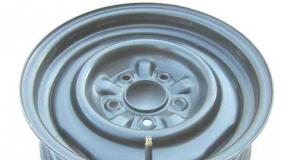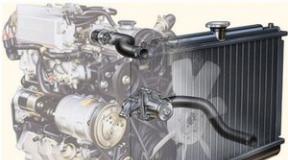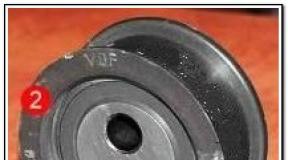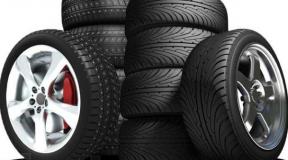The volume of oil in the prado engine is 120 4.0. Recommendations for changing engine oil in the engine of a Toyota Land Cruiser Prado
Toyota Land Cruiser Prado cars are not only in great demand, but also in great respect. This is a large SUV with good technical specifications, reliable power units, comfortable interior and impressive durability. Therefore, even samples from the 90s are still in demand, are in excellent condition and can impose competition on many modern cars.

Operating conditions affect the frequency of replacement engine oil in Toyota Land Cruiser Prado.
Tasks of motor oils
But in order for the machine to serve for a long time and efficiently, it requires appropriate care. One of the main conditions for maintaining the efficiency of the motor is the timely replacement of motor, transmission oils and other consumables. Not every car owner knows what oils to pour into the Toyota Prado 150 with a diesel engine, which often causes problems, you need to contact car services. The maintenance of such a car is not cheap, therefore, each visit to the service station costs the owner a large sum. Timely replacement and competent for the Toyota Prado car allows you to:
- maintain the performance of all engine elements;
- cool the system
- ensure the operation of other nodes associated with the power unit;
- maintain an optimal level of working fluids;
- maintain the original engine power;
- guarantee high vehicle dynamics;
- prevent serious damage and costly repairs.
Therefore, it is important for Toyota Prado owners to monitor the condition of the car, in the engine and use only compounds recommended by the manufacturer.
Oil change interval
If you ignore the need to change engine oil, it will gradually begin to thicken, change its consistency and lose its physico-chemical properties. Dust, dirt, particles of chips formed as a result of friction of parts of the power unit will get into the liquid. All this negatively affects the performance of the car, regardless of the engine installed on the Toyota. Such a negligent attitude towards an SUV ends with a motor breakdown and expensive overhaul.

On new engines, an oil change is carried out approximately once every 10 thousand kilometers. But this figure can decrease to 5-7 thousand kilometers, depending on the age of the car, the current state of the engine and a number of other factors. There are drivers who do not roll these 5-10 thousand kilometers during the year. Then change the oil already according to temporary indicators, that is, once a year. The following factors influence the frequency in the Toyota Land Cruiser Prado engine:
- the quality of the lubricant used in the motor;
- intensity of operation of the machine;
- current technical condition;
- seasonality;
- sharp temperature changes;
- aggressive driving style;
- road quality;
- fuel used;
- long idle time of the car in the garage or in the parking lot;
- frequent driving in mountainous and hilly areas;
- regular overloading of the car by weight (driving with a lot of cargo, constant use of a trailer).
Engine oil selection
The first thing to start with is the choice of fresh fluid to fill in the engine. Owners of Prado SUVs are interested in what kind of oil to pour into the engine, and what characteristics should be paid attention to. According to the official operating instructions that the manufacturer, represented by Toyota, attaches to their SUVs, the viscosity grades of the motor fluid should be:
- 10W30;
- 5W30;
- 5W20;

The recommended viscosity of the car oil and the temperature in which the car is operated are closely related to each other. Therefore, for each parameter of the viscosity of the motor fluid, there are recommended temperature limits. The choice largely depends on which region you live in, how severe winters there are or how mild the climate is with fairly high temperatures even in winter. Japanese automaker recommend pouring in power units SUVs "Land Cruiser Prado" original oils that bear the appropriate name Toyota Motor Oil with characteristics suitable for a particular season and engine, viscosity, quality class, etc.
But the problem is that such original liquids are quite expensive. There are many worthy analogues on the market at a lower price. But it is not recommended to take too cheap ones either, since their efficiency will be noticeably lower, which will negatively affect the resource and quality of the power plant. Therefore, the best alternative for official engine oil from Toyota are:
- Mobil;
- shell;
- total;
- Liqui Moly;
- Castrol.
Choose among these manufacturers based on the recommended characteristics of motor lubricants for your Prado.
Filled oil volume
This question is the most relevant, because different engines and generations have their own indicators of the volume of lubrication. Today there are a total of 3 generations of Prado, not counting restyled versions:

90 "Cruisers" are no longer so relevant and are rare. Each of the last two generations is widely represented in the market of new and used cars, therefore it will be relevant to talk about the versions presented and the engines with which they can be equipped. The volume will be indicated by two digits. The smaller one provides for the required amount without changing the filter, and the larger number indicates how much lubricant will need to be filled in while changing the oil filter.
Let's say in advance that when changing the lubricant in the power unit, it is recommended to change the filters in parallel. This is also a consumable item with a limited service life.
120 (2002 - 2009 model years)
- in gasoline engines "Prado 120" with a volume of 2.7 liters with a capacity of 163 liters. With. pour 5.1 - 5.8 liters. lubricants;
- in a 3-liter diesel with 173 hp includes from 6.7 to 7.0 liters of engine oil;
- a Prado 120 gasoline engine of 4.0 liters and 249 horsepower requires 4.9 - 5.2 liters. oils.
150 (2009 - 2013 model years)
- 5 - 5.7 liters are poured into a 163-horsepower gasoline engine. lubricants;
- diesel 3.0 liters and 173 liters. With. requires 6.7 - 7 liters of liquid;
- petrol 4.0-liter engine with 282 hp. With. needs 5.7 - 6.1 liters. oils.
150 (2013 - 2015 model years)
- junior gasoline engine of 2.7 liters and 163 liters. With. uses 5 - 5.7 liters of lubricant;
- three-liter diesel engine with 173 liters. With. requires 6.7 - 7.0 liters;
- older gasoline engine with 282 hp With. filled with grease for 5.7 - 6.2 liters.

In the last generation gasoline engine sample 2015 - 2017 model years, which has a volume of 2.7 liters and 163 horsepower power, car owners should take about 5.5 - 5.9 liters of motor lubricant. Be sure to pour into the Prado 120 and 150 the oil that corresponds to the official instruction manual. Consider the total volume of oil in the Prado 120 engine and its latest version 150. Knowing which engine oil is best suited for such a car, you can start replacing it yourself.
There is nothing complicated about this, although many owners of such cars do not bother to maintain a Japanese SUV on their own, but simply entrust the work to specialists at a car service. This is largely correct if you contact qualified craftsmen and authorized Toyota dealers with stations Maintenance. But it also happens that you want or need to change the lubricant with your own hands. To do this, you need to know what oil is already in the engine, drain it and.
Checking the level and condition
Each car owner is obliged to carefully monitor the condition of his car, the behavior of the Toyota Prado, and the operation of the engine. Many signs clearly indicate that it is time to change the oil. If you buy an SUV from your hands, it makes sense to immediately change the lubricant and filter. The following points indicate the need to replace the lubricant:
- gears begin to switch insufficiently clearly;
- the engine runs, but does not develop maximum speed;
- there is a lack of power;
- increase in fuel consumption;
- vibrations and extraneous noise occur during movement.
Sometimes these signs also indicate more serious problems. But first, check the level and condition of the oil. To do this, remove the special probe, which is located in the engine compartment, wipe it with a dry cloth, insert it into place and remove it again. By the marks on the dipstick, you will see at what level the lubricant is in the motor. Additionally, a little oil can be dripped onto white paper and carefully examined. If you see particles of debris, dust and dirt, this indicates a clearly poor condition of the fluid. It would be ideal to compare the old oil with the new one. If there are significant differences in color (the old one is darker), be sure to replace it.
It differs somewhat depending on the type of engine and the generation of the Japanese SUV itself. But structurally, in this regard, the machines did not change much, which makes it possible to change the working fluid approximately according to the same scheme. If the check showed that it is time to change the lubricant, start from the following algorithm of actions:

The flushing stage raises logical questions that the use of chemical compounds can adversely affect the operation and condition of the motor. After all, partially the mixtures remain in the system, which is why they can react with new oil, foam and lead to the formation of a new plaque, deposits and pollution.
Therefore, experienced Toyota Prado owners advise replacing flush mixtures with semi-synthetic or mineral oils. They are flushed, and then the working synthetic mixture is already poured. In order to optimize the operation of Prado engines and prevent premature wear of parts due to the loss of its physical and chemical properties by oil, owners of such SUVs should refuel only at high-quality gas stations.
Thank you all for your attention! Subscribe to our site, leave comments, ask questions and tell your friends about us!
The Toyota Land Cruiser Prado is a full-size SUV that is extremely reliable and durable, with a solid and proven design. This model considered the best-selling SUV in Russia among classmates. This is not surprising, given not only good driving performance and high reliability, but also the possibility self service despite the rather complex structure. At the very least, we are talking about performing elementary repair procedures, such as changing engine oil. In fact, even an inexperienced owner of the Toyota Land Cruiser Prado will cope with this task, if you carefully read the user manual. As you know, the process of changing the oil is preceded by the choice of the oil itself. This procedure is more responsible, and requires little knowledge in the field of theory, including various parameters and standards. In this article, using the Toyota Land Cruiser Prado as an example, we will consider in detail how to choose the right engine oil, as well as how much to fill it in, depending on the displacement of the internal combustion engine and the model year of the car.
Replacement frequency
It must be said right away that the official oil change regulations for Toyota Land Cruiser may not be relevant if the car is often operated in difficult climatic and road zones. For example, when driving only in the city, it is enough to pay attention to the regulations, which are about 15 thousand kilometers. But since we have an SUV in front of us, it is often used off-road. In this regard, a more frequent oil change may be required, since under the influence of negative factors, the liquid quickly loses its useful properties, and as a result becomes unusable. For example, experienced Russian owners who regularly subject their Land Cruiser to extreme loads prefer to change the oil every 7-10 thousand kilometers. When driving around the city, taking into account the variable climate, the frequency of replacement can be 10-12 thousand km.
How to determine the quality of the oil
To understand that the oil has become unusable and needs to be replaced, to do this, look at its color, and pay attention to the smell and composition of the liquid. So, if the oil is colored dark brown, and also has a specific smell of burning and contains foreign impurities (metal chips, mud deposits, soot, dust, etc.), in this case, an oil change can be immediately added to the list of the most urgent tasks for the near future.
When to Check Your Oil
There are several generally accepted signs, upon detection of which it will not be superfluous to check the condition of the lubricant:
- Fuzzy gear shifting
- The engine is running and is not able to develop maximum speed
- Engine running at partial power
- Increased fuel consumption
- High level of vibrations and noises
Types of motor oils
There are only three types of lubricants on the market, which are the most popular among all the others:
- Synthetic oil is the most demanded product among foreign cars, including all modern cars. This oil has good non-stick and extreme pressure properties and, due to its high fluidity, is quite stable at low temperatures. Thanks to this, synthetics can be recommended to owners of Toyota Land Cruiser Prado with low mileage, as well as for operation in harsh winter conditions - for example, in Siberia.
- Mineral oil is the exact opposite of synthetic. In frosty weather, mineral water can quickly thicken, which is an advantage, and at the same time a disadvantage. The downside is that it instantly freezes, and the advantage is the absence of oil leaks, which are prone to cars with high mileage. The absence of leaks is due to the excessive density of mineral oil, and as a result, it may not pass even through a microcrack in the body. Mineral water is more suitable for older cars, including Land Cruisers with high mileage.
- Semi-synthetic is a fairly high-quality oil, despite its significant shortcomings. It consists of 70% mineral and 30% synthetic oils. It is also used for cars with high mileage. The main advantages of semi-synthetics are that such an oil resists low temperatures a little better, and has a longer shelf life.
Based on the data obtained for each of the three motor oils, we can conclude that for Toyota Land Cruiser Prado the best option will synthetic oil, and the second place is occupied by semi-synthetics.
Now consider the parameters of engine oil, as well as how much to fill it in, depending on the type of engine and its displacement.
How much oil to pour: generations, engines
Model range 2002-2009 (Prado 120)
For gasoline engine 2.7 2TR-FE 163 hp With.:
- How much to fill 5.8 - 5.1 liters
- SAE parameters - 5W-30, 10W-30
- API Standard - SJ, SL, SM, SN
For diesel engine 3.0 TD 1KD-FTV 173 l. With.:
- How much to fill - 7.0 / 6.7 liters
- Standards – DLD-1, ACEA B1, API CF-4, СF
For gasoline engine 1GR-FE 4.0 249 liters. With.:
- How much to fill - 5.2 - 4.9 liters
- SAE parameters - 15W-40, 20W-50
- API standards - SJ, SL, SM, SN
Model range 2009-2013 (Prado 150)
- How much to fill - 5.7-5.0 liters
- API standards - SL, SM, SN
- How much to fill - 7.0-6.7 liters
- SAE parameters - 5W-30, 10W-30, 15W-40, 20W-50
- API standards - G-DLD-1, ACEA - B1, API - CF-4; CF
For gasoline engine 1GR-FE 282 hp from 4.0 l.:
- How much to fill - 6.1 - 5.7 liters
- SAE parameters - 0W-20, 5W-20, 5W-30, 10W-30
- API standards - SL, SM, SN
Model range 2013 - 2015 (Prado 150 restyling)
For gasoline engine 2TR-FE 2.7 163 hp With.:
- How much to fill - 5.7-5.0 liters
- SAE parameters - 0w-20, 5W-20, 5W-30, 10W-30
- API standards - SL, SM, SN
For diesel engine 3.0 1KD-FTV 173 l. With.:
- How much to fill - 7.0-6.7 liters
- SAE parameters - 0W-30, 5W-30, ACEA C2, 10W-30, 15W-40, 20W-50
- API standards - CF-4, CF
For gasoline engine 1GR-FE 282 hp With.:
- How much to fill - 6.2-5.7 liters
- SAE parameters - 0W-20, 5W-20, 5W-30, 10W-30
- API standards - SL, SM, SN
Lineup 2015 – present v.
For petrol engine Prado 150 2.7 2TR-FE 163 hp With.:
- How much to fill - 5.9-5.5 liters
- SAE parameters - 0W-20, 5W-20, 5W-30, 10W-30
- API standards - SL, SM, SN
The best manufacturers of motor oils
When choosing oil for Toyota Land Cruiser Prado, you should proceed from the parameters indicated on the label of the original Toyota 5W-30 product, or in the user manual. Alternatively, you can prefer an analogue oil, which is practically not inferior in quality to the original oil. So, among the best manufacturers of analogue oils, Lukoil, Castrol, Shell, Elf, Mobile and others can be distinguished.
In our conditions, it is recommended to change the oil in the Prado automatic transmission every 60-80 thousand. km., but let's not forget about regular checks lubricant. If you drive mainly on the highway at low speed, then the replacement can be carried out every 100 thousand km. In the conditions of the service, the work will be expensive, so let's figure out how to do it yourself. Toyota PradoEven though Toyota Prado has a fairly high ground clearance, it is better to replace it on a lift or a pit, not forgetting about your safety. For work we need:
- container for draining old oil
- rags
- 10 or 17 socket ratchet or similar wrenches
- automatic transmission pan gasket for your Prado
- transmission oil
- filter
- sealant
- long hose with a diameter of 10 mm.
Detailed instructions on how to change the oil in a Toyota Prado 120
First. spin drain plug automatic transmission crankcase, but do not forget to substitute a canister or other container to drain the used oil. Unscrew the drain plugIt will be around 11 liters. We wait until the oil is completely drained from the box (it will take about 15-20 minutes), after which we proceed to dismantle the crankcase.
Second. We remove the pan by unscrewing the bolts in a circle - there may still be a little oil left in it, so remove it carefully.
Third We wipe the inside of the pan with rags and carefully cut off the old sealant. We wipe the automatic transmission pan
Fourth. Next, if necessary, unscrew the oil filter bolts and replace it. Remove the automatic transmission oil filter
Fifth. After that, we install a new automatic transmission pan gasket, lubricate a little on top with sealant and screw it into place.
Video oil change in automatic transmission Toyota Prado 120 body
Slowly pour six liters of oil into the upper hole. Then remove the lower branch pipe of the heat exchanger and connect a hose to it. We insert the hose into the canister, then we start the car in the "P" mode. Transmission oil should be poured through the hose into the canister. When 4-4.5 liters are typed, we turn off the car and add the same amount to the automatic transmission.
Detailed video instruction for oil change in automatic transmission TLK Prado 120
Capacity 4-stage automatic box 10.9 liters, during the replacement it will be necessary to drive around 16 liters.
Then close the filler plug and start the car again. To warm up the oil, you need to switch the selector in all modes.
The formation of a strong protective film on the internal elements of the motor is possible if an oil corresponding to the parameters of the engine is used. The film formed by the oil protects the power unit from overheating and premature wear. Our article describes the characteristics of the recommended engine oil for Toyota Prado.
Model 2001 release.
Petrol power units
 Scheme 1. Recommended viscosity for 5VZ-FE engines.
Scheme 1. Recommended viscosity for 5VZ-FE engines. Based on scheme 1, 5w-30 all-weather oil is poured at temperatures below +8 0 C, it is perfect for the winter. At the same time, 10w-30 is used at temperatures above -18 0 C.
 Scheme 2. Recommended viscosity for 3RZ-FE motors.
Scheme 2. Recommended viscosity for 3RZ-FE motors. According to scheme 2, for very low temperatures, it is worth using 5w-30 motor oils, and at temperatures above -18 0 C, use lubricants 10w-30, 15w-40, 20w-50.
Diesel car engines
According to the manual for engine oils for diesel engines 1KD-FTV and 1KZ-TE Toyota Prado are subject to the following requirements by the manufacturer:
- lubricant must comply with G-DLD-1 standards;
- types of lubricants CF-4 or CF according to the API system (sometimes it is allowed to use CE or CD).
Viscosity selection for 1KD-FTV engines is carried out according to scheme 3, and for 1KZ-TE engines according to scheme 4.
 Scheme 3. Dependence of the viscosity index of the lubricant (for 1KD-FTV engines) on the temperature outside the machine.
Scheme 3. Dependence of the viscosity index of the lubricant (for 1KD-FTV engines) on the temperature outside the machine. In accordance with scheme 3, the Toyota Prado manufacturer recommends filling in 5w-30 oil for a wide temperature range from -29 0 C (or less) to +38 0 C (or more). And liquids 10w-30, 15w-40, 20w-50 should be used provided that the thermometer is above -18 0 C.
 Scheme 4. The influence of ambient temperature on the selection of the viscosity of motor fluid for 1KZ-TE engines.
Scheme 4. The influence of ambient temperature on the selection of the viscosity of motor fluid for 1KZ-TE engines. According to scheme 4, 5w-30 lubricants should be used at temperatures below +8 0 C, and oils 10w-30, 15w-40, 20w-50 should be used at temperatures above -18 0 C.
Refueling volumes
Refueling tanks for Toyota Prado:
- Power units 1KD-FTV:
- 7.0 l with oil filter change;
- 6.7 l excluding filter device.
- Engines 1KZ-TE:
- 7.0 l with oil filter change;
- 6.3 liters excluding oil filter.
- Auto engines 5VZ-FE:
- 5.2 l with oil filter;
- 4.9 liters without oil filter.
- 3RZ-FE engines:
- 4.7 without oil filter;
- 5.4 with oil filter change.
The volume of engine oil between the "maximum" and "minimum" marks on the dipstick for Toyota Prado vehicles is:
- 1.5 l for 1KD-FTV motors;
- 1.2 l if auto engines 1KZ-TE.
Toyota Prado 120 2002-2009 release
 Model 2001 release.
Model 2001 release. Gasoline engines
According to the car's operating instructions, the recommended engine oil for Toyota Prado must meet the following parameters:
- original Toyota oils Genuine Motor Oil or equivalent lubricants that meet the requirements of the vehicle manufacturer for the quality of lubricants:
- universal motor fluids of class SL or SJ with the inscription "Energy Conserving" (energy-saving) according to API standards;
- motor lubricants certified by ILSAC.
The selection of the viscosity of the oil is carried out according to scheme 5.
 Scheme 5. Recommended viscosity for Toyota Prado gasoline engines.
Scheme 5. Recommended viscosity for Toyota Prado gasoline engines. According to scheme 5, if you fill in engine fluids 10w-30, 15w-40, 20w-50 at very low temperatures, then starting the engine will be difficult. For temperatures below +8 0 C, it is recommended to pour 5w-30.
Diesel power units
According to the manual for diesel engines, it is necessary to use motor oils with the following parameters:
- liquids conforming to class G-DLD-1;
- oil classes CF-4 or CF according to API classification (it is acceptable to use CE or CD).
To select the viscosity, use scheme 5.
Refueling volumes
The volume of oil between the maximum and minimum mark on the Toyota Prado dipstick is:
- 1.3 l if engines 2TR-FE
- 1.5 liters in the case of 1GR-FE or 5L-E engines;
- 1.2 l for 1KZ-TE motors.
Toyota Prado 150 since 2009
 Model 2012 release.
Model 2012 release. 1GR-FE petrol engines (GRJ150L-GKTEKW and GRJ150L-GKTEK models)
The Toyota Prado manual contains the following requirements for lubricants:
- Toyota Genuine Motor Oil branded lubricants or equivalent in terms of parameters;
- class of motor fluids SL or SM with the inscription "Energy Conserving" (energy-saving) or SN with the designation "Resource-Conserving" (resource-saving) according to API standards;
- fluids that meet the requirements of ILSAC and have a viscosity of 15w-40.
You can select the viscosity of the oil for the GRJ150L-GKTEKW model according to scheme 6, and for the GRJ150L-GKTEK model according to scheme 7.
 Scheme 6. Recommended viscosity of engine fluid for the GRJ150L-GKTEKW model.
Scheme 6. Recommended viscosity of engine fluid for the GRJ150L-GKTEKW model. The manufacturer in the car manual indicates that it is preferable to fill in 0w-20 liquids, they are designed for a wide temperature range from -18 0 C (or less) to +27 0 C (or more). If there are no 0w-20 motor oils, then 5w-30 can be used, but the next time you change it, you need to fill in 0w-20. Liquids 10w-30, 15w-40 are poured at an air temperature of more than -18 0 C, it is better to pour 15w-40 for the summer.
 Scheme 7. Recommended motor oil viscosity for the GRJ150L-GKTEK model.
Scheme 7. Recommended motor oil viscosity for the GRJ150L-GKTEK model. According to scheme 7, at a temperature index below +10 0 С, 5w-30 is used. If the air temperature is above -18 0 C, pour 10w-30 or 15w-40.
Petrol engines 2TR-FE
According to the Toyota Prado instructions, oils with the following characteristics should be used:
- type of motor oil SL or SM with the designation "Energy Conserving" (energy-saving) or SN with the marking "Resource-Conserving" (resource-saving) according to API standards;
- motor oils that meet ILSAC requirements and have a viscosity of 15w-40.
To select the viscosity parameters of engine oil, use Scheme 8.
 Scheme 8. Recommended viscosity of the oil and the temperature at which it is permissible to use it.
Scheme 8. Recommended viscosity of the oil and the temperature at which it is permissible to use it. At extremely low temperatures, to ensure a quick engine start, it is recommended to use 0w-20, 5w-20, 5w-30. With a thermometer reading above -18 0 C, it is advisable to use 10w-30 or 15w-40.
Diesel auto engines 1KD-FTV (model KDJ150L-GKFEYW and KDJ150L-GKAEYW)
According to the manual for the Toyota Land Cruiser Prado, the car manufacturer recommends filling in motor oils with the following characteristics:
- original Toyota Genuine Motor Oil lubricants or equivalent oil parameters;
- CF-4 or API CF;
- B1 according to ACEA standards.
Use Chart 9 to select viscosity.
 Scheme 9. Recommended motor oil viscosity depending on the temperature outside the car.
Scheme 9. Recommended motor oil viscosity depending on the temperature outside the car. Based on scheme 9, at extremely low temperatures it is preferable to pour 5w-30, while lubricating fluids 10w-30 or 15w-40 will not provide a quick engine start, they are used at temperatures above -18 0 C
Diesel engines 1KD-FTV (model KDJ150L-GKAEY except for EURO IV)
- branded Toyota Genuine Motor Oils or alternative lubricants that have the appropriate characteristics;
- according to API classification of CF-4 or CF lubricants (it is acceptable to use CE or CD);
- according to ACEA class B1.
The choice of lubricant viscosity is performed using scheme 10.
 Scheme 10. The recommended viscosity of the car oil and the temperature at which it is permissible to use it.
Scheme 10. The recommended viscosity of the car oil and the temperature at which it is permissible to use it. According to scheme 10, it is preferable to use 5w-30 motor oils under temperature conditions from -18 0 С (and lower) to +27 0 С (and higher), 10w-30, 15w-40 and 20w-50 are used at temperatures above -18 0 С .
Diesel power units 1KD-FTV (model KDJ150L-GKAEY complies with EURO IV)
- lubricants corresponding to CF-4 or CF according to the API system;
- B1 according to ACEA standards.
The viscosity of the lubricant is selected according to scheme 9.
Diesel engines 1GD-FTV
- original Toyota Genuine Motor Oil lubricants or motor oils with similar characteristics;
- ACEA class C2 only.
Viscosity selection is performed according to scheme 11.
 Scheme 11. Recommended lubricant viscosity.
Scheme 11. Recommended lubricant viscosity. It is preferable to use 0w-30 oils; they provide optimal consumption of the fuel mixture by the car, as well as quick start of the engine in cold weather. In the absence of these lubricants, it is permissible to pour 5w-30.
Refueling volumes
The volume of engine fluid required for replacement is:
- 1GD-FTV engines:
- 7.7 l with oil filter;
- 7.2 liters without changing the oil filter.
- Power units 1KD-FTV:
- 7.0 l with oil filter;
- 6.7 liters without oil filter.
- Motors 2TR-FE:
- 5.9 l with filter;
- 5.5 liters without oil filter.
- Power units 1GR-FE:
- 6.2 l with oil filter;
- 5.7 liters without filter.
Conclusion
The recommended engine oil for Toyota Prado must have the appropriate markings, tolerances on the canister, as well as marks indicating the quality of the engine oil. Figures 1, 2 and 3 show signs that make it easier for the consumer to choose.
 Figure 1. Car oil certified by ILSAC.
Figure 1. Car oil certified by ILSAC.  Figure 2. API service symbol.
Figure 2. API service symbol.  Figure 3. The DLD trademark indicates that the oil complies with ACEA, AAM, EMA, JAMA standards.
Figure 3. The DLD trademark indicates that the oil complies with ACEA, AAM, EMA, JAMA standards.



















